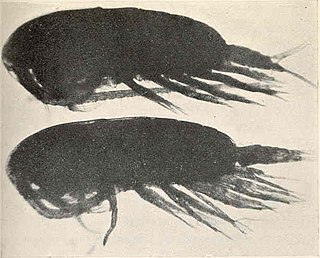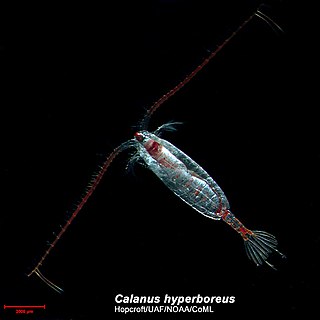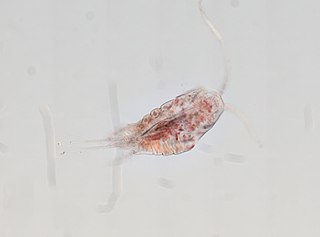Related Research Articles

Plankton are the diverse collection of organisms found in water that are unable to propel themselves against a current. The individual organisms constituting plankton are called plankters. In the ocean, they provide a crucial source of food to many small and large aquatic organisms, such as bivalves, fish and whales.

Copepods are a group of small crustaceans found in nearly every freshwater and saltwater habitat. Some species are planktonic, some are benthic, a number of species have parasitic phases, and some continental species may live in limnoterrestrial habitats and other wet terrestrial places, such as swamps, under leaf fall in wet forests, bogs, springs, ephemeral ponds, and puddles, damp moss, or water-filled recesses (phytotelmata) of plants such as bromeliads and pitcher plants. Many live underground in marine and freshwater caves, sinkholes, or stream beds. Copepods are sometimes used as biodiversity indicators.

Calanus finmarchicus is a species of copepods and a part of zooplankton, which is found in enormous amounts in the northern Atlantic Ocean.
Acartia tonsa is a species of marine copepod in the family Acartiidae.

Calanus hyperboreus is a copepod found in the Arctic and northern Atlantic. It occurs from the surface to depths of 5,000 metres (16,000 ft).
Calanus glacialis is an Arctic copepod found in the northwestern Atlantic, adjoining waters, and the northwestern Pacific and its nearby waters. It ranges from sea level to 1,800 metres (5,900 ft) in depth. Females generally range from about 3.6 to 5.5 millimetres in length, and males generally range from about 3.9 to 5.4 millimetres in length.
Calanus helgolandicus is a copepod found in the Atlantic, from the North Sea south to the western coast of Africa. The female has an average size of about 2.9 millimetres (0.11 in) and the male has an average size of about 2.7 millimetres (0.11 in).
Calanus pacificus is a species of copepod found in the Pacific Ocean. The female has an average length of about 3.1 millimetres (0.12 in), and the male has a value of about 2.9 millimetres (0.11 in).

Calanoides acutus is a copepod found in Antarctica and the surrounding waters.
Metridia longa is a copepod found in the Arctic, the north Atlantic, the Pacific, and surrounding waters. The female has an average length of about 4.2 millimetres (0.17 in), and the males have an average length of about 3.5 millimetres (0.14 in).
Neocalanus plumchrus is a large copepod found in the Pacific and Arctic Oceans. It was described in 1921 by Marukawa. N. flemingeri used to be placed in this species, likely as a form, until it was split in 1988 by Charles B. Miller.
Neocalanus cristatus is a species of copepod found primarily in the northern Pacific.
Eucalanus bungii is a copepod found in the north Pacific and surrounding waters.
Pseudocalanus newmani is a copepod found in Arctic and northern Pacific waters. It was described by Frost in 1989. It is found in the Arctic and surrounding waters. There are multiple generations. Unlike some copepods, P. newmani undergoes reverse diel vertical migration, descending during the night, and ascending during the day, although it may undergo normal or no migration at all depending on predation. This copepod is primarily herbivorous.
Calanus sinicus is a copepod found in the northwest Pacific.
Rhincalaus nasutus is a copepod in the family Rhincalanidae.

Temora stylifera is a copepod primarily found in the Atlantic and surrounding waters.

Paracalanus parvus is a copepod found throughout the world, except the Arctic.
Metridia gerlachei is a copepod found primarily in Antarctic and sub-Antarctic waters.
Pseudocalanus minutus is a small copepod found in the Arctic Ocean and surrounding waters.
References
- 1 2 Razouls C.; de Bovée F.; Kouwenberg J.; Desreumaux N. (2018). "Diversity and Geographic Distribution of Marine Planktonic Copepods". Sorbonne Université, CNRS. Retrieved 16 August 2018.
- ↑ "Pseudocalanus newmani" at the Encyclopedia of Life
- 1 2 3 Renz, J.; Mengedoht, D.; Hirche, H.-J. (2008). "Reproduction, growth and secondary production of Pseudocalanus elongatus Boeck (Copepoda, Calanoida) in the southern North Sea". Journal of Plankton Research. 30 (5): 511–528. doi: 10.1093/plankt/fbn016 . ISSN 0142-7873.
- 1 2 Digby, P. S. B. (1950). "The biology of the small planktonic copepods of Plymouth". Journal of the Marine Biological Association of the United Kingdom. 29 (2): 393–438. doi:10.1017/S0025315400055442. ISSN 0025-3154. S2CID 85799459.